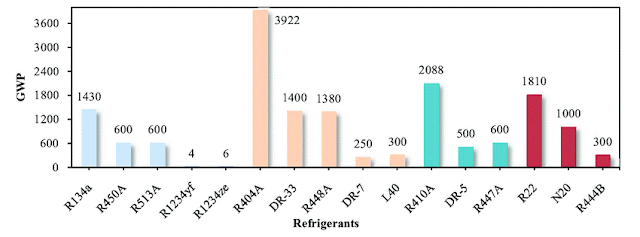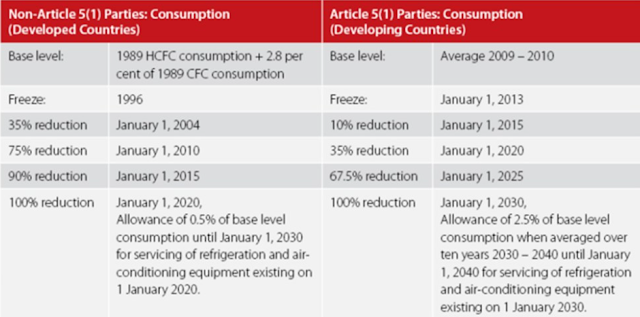Eco-Friendly Refrigerants
Eco-Friendly Refrigerants
What is Refrigerant?
Fig.1 Refrigerants
Selection of Refrigerant:
Fig.2 Selection Criteria
Environmental and safety properties:
The environmental friendliness of refrigerants is an important factor in determining the usefulness of a particular refrigerant. Important environmental and safety characteristics include:
Ozone Depletion Potential (ODP): The ODP of refrigerants
should be zero, according to the Montreal protocol. Because ODP is primarily
determined by the presence of chlorine or bromine in the molecules,
refrigerants containing either chlorine or bromine are prohibited under the new
regulations.
Global Warming Potential (GWP): Refrigerants directly contribute to global
warming when they are released into the atmosphere. indirect contribution based
on energy use, including that of the compressors (CO2 produced by power
stations).To reduce the issue of
global warming, refrigerants should have a low GWP rating.
The Total Equivalent Warming Index (TEWI): which considers
refrigerants direct and indirect effects on global warming. Low TEWI
refrigerants are obviously favored from the perspective of reducing global
warming.
Toxicity: Refrigeration system refrigerants should ideally
be non-toxic. Toxicity is a relative term that only has meaning when the level
of concentration and duration of exposure required to cause harmful effects are
specified.
Flammability: The refrigerants should be non-flammable and
non-explosive if possible. To avoid accidents with flammable refrigerants,
special precautions should be taken.
Chemical stability: Refrigerants must be chemically stable
while inside the refrigeration system.
Ease of Leak Detection: In the event of leakage of
refrigerant from the system, it should be easy to detect leaks.
The major categories of refrigerants are:
Chlorofluorocarbons (CFCs):
CFCs are chlorine, fluorine, and
carbon atom compounds that are used to make aerosol sprays, blowing agents for
foams and packing materials, solvents, and refrigerants. They are regarded non-eco-friendly
refrigerant gases because to their high ODP (Ozone Depletion Potential) and GWP
(Global Warming Potential).
Examples include R11, R12, R113,
R114, and R115.
Hydrochlorofluorocarbons (HCFCs):
HCFCs are chemical compounds made up of hydrogen, chlorine, fluorine, and carbon atoms. HCFC refrigerants have a medium to high GWP and are commonly utilized in refrigeration and air conditioning systems. Once again, these are not ecologically friendly refrigerant gases that have been phased out or are being phased out in most nations.
For instance, R22, R141b, R123.
Fig.4 R-141B (HCFC)
Hydrofluorocarbons (HFCs):
HFCs, a fluorocarbon mixture,
have no ODP and a moderate to high GWP, making them a greener option to CFCs
and HCFCs. HFCs are used in foam making, refrigeration, and other operations to
replace CFCs. HFCs may contribute to global warming, but they have no direct effect
on the ozone layer.
Examples are R32, R134a, and
R152a.
Fig.5 R-134a (HFC)
Hydrofluoro-olefins (HFOs):
HFOs are made up of the same three atoms as HFCs, but they are unsaturated organic compounds, hence the suffix "olefin. "They have a double bond between two carbon atoms with their parent hydrocarbon. Because of the double bond, the molecules are less stable and degrade swiftly in the atmosphere—in days rather than years or decades for HFCs. Because they have no ODP and a relatively low GWP, HFO refrigerants are claimed to be the most environmentally benign refrigerants currently available.R449A, R454C, R513A, R1234yf, R1234ze, R1233zd, R1336mzz are HFO refrigerants found in commercial and industrial air conditioning and refrigeration systems, water chillers, vehicles, portable air conditioners, and heat pumps.
Fig.5 R1234yf, R1234ze (HFO)
Inorganic refrigerants:
Carbon Dioxide: There is no ODP or GWP. Non-flammable and
non-toxic. Low-cost and widely available. Its high operating pressure allows
for system size and weight reduction potential.
Ammonia: ODP and GWP are both zero. Excellent thermodynamic
properties: low molecular mass, high latent heat, high vapor density, and
excellent heat transfer properties. High critical temperature (132 degrees
Celsius): highly efficient cycles at high condensing temperatures. Its odor
causes leaks to be detected and repaired before they reach dangerous
concentrations. Price is Reasonably Low.
Water: ODP and GWP are both zero. In an absorption system, water is used as a refrigerant. New developing technology has made room for it to be used in compression cycles as well. However, higher than normal working pressure in the system can play a role in the limited use of water as a refrigerant.
Table.1 Refrigerant Properties.
Graph.1 Overall review of GWP of Refrigerants
Montreal Protocol:
The Montreal Protocol is a
historic international agreement aimed at preserving the stratospheric ozone
layer.
The Montreal Protocol, officially
the Protocol on Substances that Deplete the Ozone Layer, is a treaty signed on
September 16, 1987, in Montreal by 25 states; it presently has 168 signatories.
The protocol-imposed restrictions
on the manufacturing of chlorofluorocarbons (CFCs), which are organic molecules
containing carbon, chlorine, and fluorine atoms. CFCs are highly efficient
refrigerants developed in response to the urgent need to eliminate harmful and
combustible compounds.
The protocol calculates the
ozone-depleting potential, or ODP, of any substance in relation to an equal
quantity of CCl3F, or CFC-11, which is assigned a value of 1.0.
Table.3A
Refrigerants phase out period
Table.3B
Reduction in consumption for Developed and Developing Countries
Application of New Eco-friendly Refrigerants:
Benefits of Eco-friendly refrigerants:
Recycling or disposal after use in refrigeration systems is relatively easier than CFCs, HCFCs and HFCs.
In general, these gases are more energy efficient than F-gas. The chemical industry has not patented these refrigerants, which are less expensive than HFCs.
These gases are not hazardous to the environment and can be handled with care.
These gases are produced as by-products of other processes. If you can set up a good distribution structure, it will be easier to make them available out of the box.
Conclusion:
The environmental friendliness of a refrigerant can be
measured by its ODP (Ozone Depletion Potential) and GWP (Global Warming
Potential).
CFCs, HCFCs, and HFCs are chemically synthesized and do not
occur as natural compounds. Moderate to high ODPs and GWPs are being phased out
under the Montreal Protocol (1987) because they are extremely harmful to the
environment.
HFO is a synthetically produced unsaturated HFC with no ODP
and low GWP, making it the greenest refrigerant gas with the least negative
environmental impact.
Natural refrigerant he has zero ODP and very low GWP, making it an ideal replacement for CFC, HFC and HCFC. They are naturally occurring substances such as CO2, ammonia, water and air. They may be hydrocarbons. propane, isobutene, propene or propylene.
References:
1.HCFC phase out schedule and
baselines, Montreal Protocol, United Nation Environment Programme (UNEP).
2.Linn Mikaela Persson, Åsa
Persson, Måns Nilsson, Multilateral Environmental Agreements on the Ground –
Lessons from Supporting Implementation of the Montreal Protocol, ResearchGate
Jan 2007.
3.Vijayan Gurumurthy Iyer, Nikos
E Mastorakis, Experimental Investigations on Eco-Friendly Refrigeration and Air
Conditioning Systems, ResearchGate, Jan 2006.
4.https://www.allrefrigerants.com/blog/advantages-of-eco-friendly-refrigerant-gases.
5.Dr. Shivaprakash Bhagwatrao Barve, Eco-Friendly Refrigerants, ResearchGate, Oct 2013.
"Thanks for reading, please leave a comment :)"
Authors:
- Jaydeep Patil
- Rohit Patil
- Gokarna Lele
- Abhishek Kumbhar
- Rohit Bele
- Kedar Basutkar













Nice👍
ReplyDeleteGreat content👍
ReplyDeleteThis comment has been removed by the author.
ReplyDeleteGood Information
ReplyDeletewell informative👍
ReplyDeleteVery Crisp Information well written Enjoyed reading
ReplyDeleteNoice Information
ReplyDeleteGood Job. Keep It Up.
ReplyDeleteInformative!!
ReplyDeleteGreat Blog, Quite Informative
ReplyDeleteCrisp and very Informative
ReplyDelete